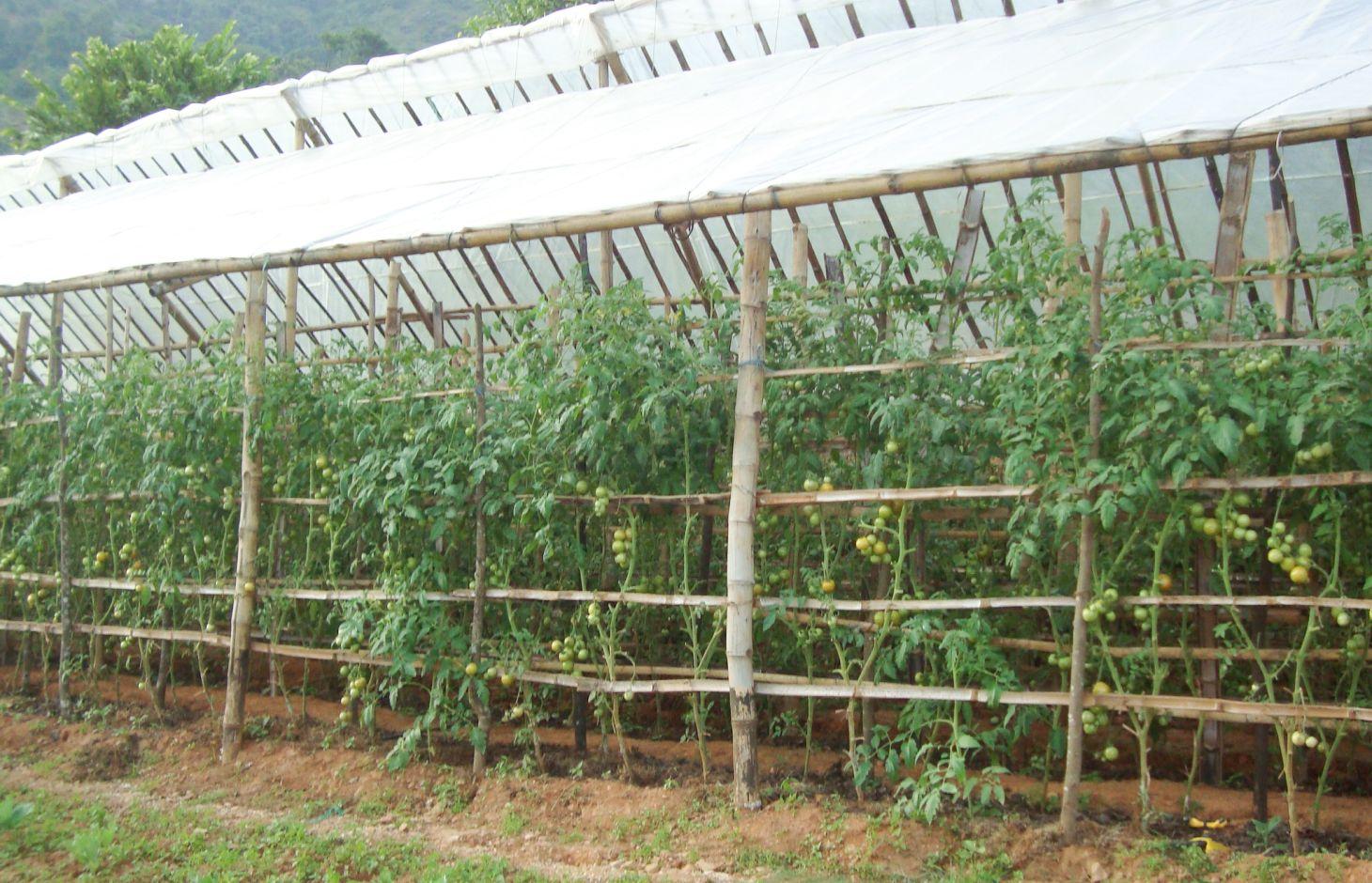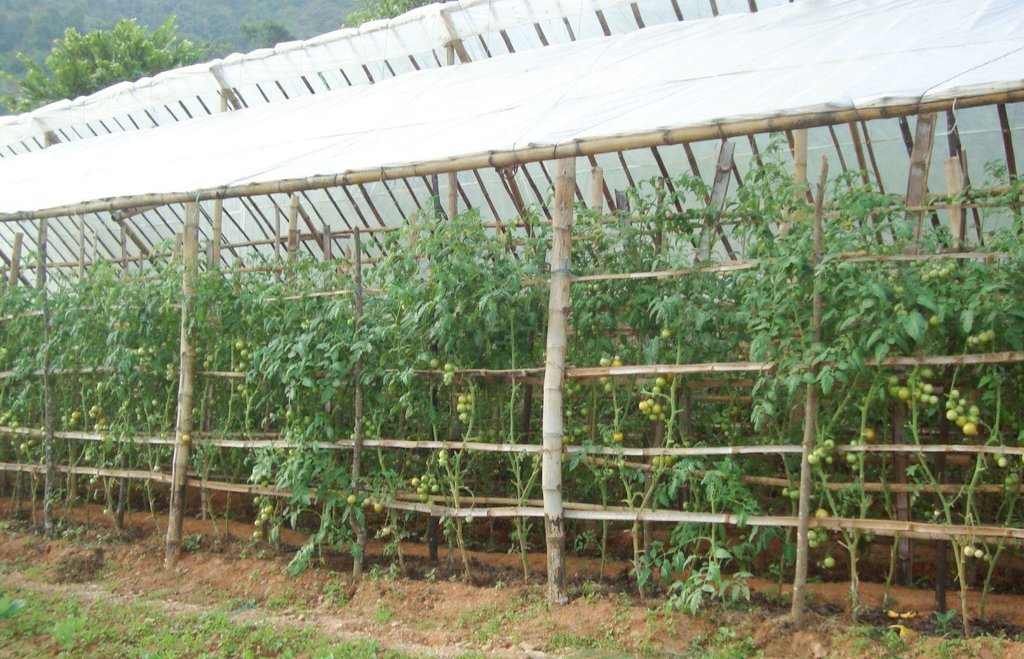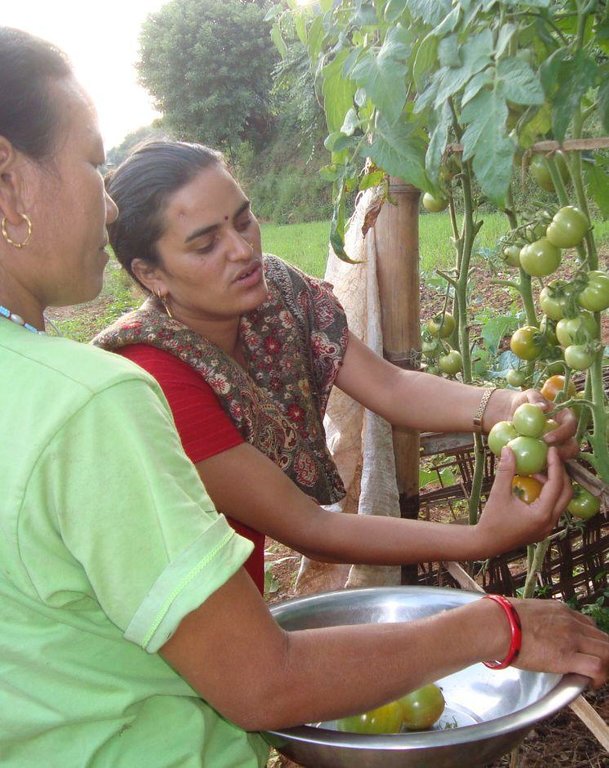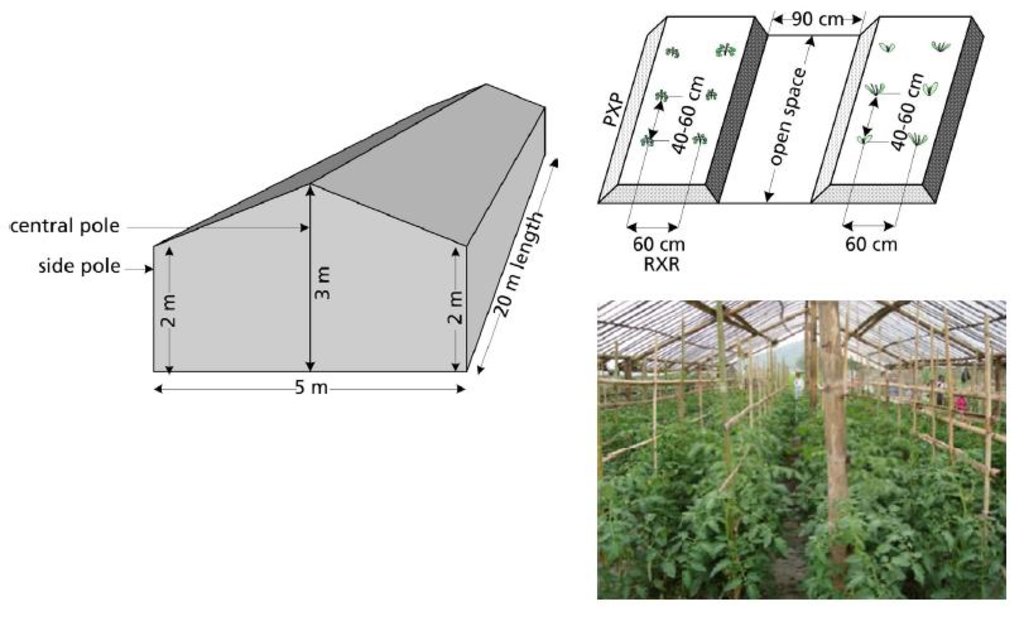A low-cost polyhouse for tomato production in the rainy season [Непал]
- Создание:
- Обновить:
- Составитель: Shreedip Sigdel
- Редактор: –
- Рецензент: David Streiff
Sasto Plastic ghar ma barsha golbheda kheti (Main Contributor: Bishnu Bishwakarma, Helvetas Nepal)
technologies_1688 - Непал
Просмотреть разделы
Развернуть все Свернуть все1. Общая информация
1.2 Контактные данные специалистов и организаций, участвующих в описании и оценке Технологии
землепользователь:
Название организации (-ий), содействовавших документированию/оценке Технологии (если применимо)
HELVETAS (Swiss Intercooperation)Название организации (-ий), содействовавших документированию/оценке Технологии (если применимо)
ICIMOD International Centre for Integrated Mountain Development (ICIMOD) - Непал1.3 Условия, регламентирующие использование данных, собранных ВОКАТ
Когда были собраны данные (на местах)?
01/03/2013
Составитель и ответственный(-ые) специалист(-ы) согласны с условиями, регламентирующими использование собранных ВОКАТ данных:
Да
2. Описание Технологии УЗП
2.1 Краткое описание Технологии
Определение Технологии:
Smallholder farmers can use polyhouses to produce high demand vegetables, such as tomatoes, and can earn a substantial income from even a relatively small plot of land in a short time.
2.2 Подробное описание Технологии
Описание:
During the wet season (June–October), the monsoon rains severely limit the type of crops that can be grown in open fields and they also restrict the production of seedlings. Low-cost polyhouses can be used to protect crops from excessive rainfall and can provide a sheltered environment for the production of better quality crops over the rainy season cropping period. For example, smallholder farmers who produce high demand vegetables such as tomatoes can earn as much as USD 350–500 from a plot of land which measures only 100 m2 in area over the short time period from June to November. This is much more than they can earn by growing any traditional crop by conventional methods. The Sustainable Soil Management Programme (SSMP) is promoting this technology in several mid-hill districts of Nepal.
Establishment / maintenance activities and inputs: Polyhouses should be situated in well-drained areas where sunshine is abundant and there is no shade throughout the cropping period. The bamboo frame can be constructed earlier in the year but the plastic roofing is not added until after one or two rainfall events. The height of the polyhouse frame varies depending on the altitude. At higher elevations, the polyhouses are lower to help trap more heat and moisture, whereas at lower elevations the polyhouses are higher to allow more air to circulate and moisture to evaporate. The preparations, which take place mid-May to early June, consist of fertilizing the soil and planting the tomato seedlings. Throughout the growing season the tomato plants are staked, trained, and pruned and a top dressing of fertilizer is added to produce a higher quality product.
2.3 Фотографии, иллюстрирующие Технологию
2.5 Страна/ регион/ места, где применяется Технология, информация о которых собрана в данной Анкете
Страна:
Непал
Более точная привязка места:
Mid Hills of Nepal
2.7 Внедрение Технологии
Укажите, как именно Технология УЗП была внедрена:
- через проекты/ внешнее вмешательство
3. Классификация Технологии УЗП
3.1 Основные цели и задачи реализации Технологии
- повышение производства
- создание благоприятных экономических условий
3.2 Текущий(-ие) тип(-ы) землепользования на территории, где применяется Технология

Пахотные угодья и плантации
- Однолетние культуры
Пояснения:
Major land use problems (compiler’s opinion): In the mid-hills of Nepal, the arable land of most farm households has been divided into very small plots. If this land is used to produce traditional crops such as maize, wheat, and millet using conventional farming methods, it cannot provide full employment for all of the householders and cannot yield sufficient cash income for the household. The risk of intense rainfall during the monsoon season, which can damage crops, has prevented these farmers from switching to more lucrative high value crops.
3.3 Дополнительная информация о землепользовании
Число урожаев за год:
- 1
Поясните:
Longest growing period in days: 214; Longest growing period from month to month: May to November
3.4 Категория УЗП, к которой относится Технология
- Greenhouses
3.5 Распределение Технологии по площади
Охарактеризуйте пространственное распространение Технологии :
- равномерно-однородное применение на определенной площади
Если Технология равномерно применяется на той или иной территории, укажите ее приблизительную общую площадь:
- 1-10 км2
3.6 Мероприятия УЗП, выполняемые в рамках Технологии

Агрономические мероприятия
- A6: Другие
3.7 Основные проблемы деградации земель, на решение которых направлена Технология

водная эрозия почв
- ВЭп: поверхностная эрозия/смыв верхних почвенных горизонтов
Пояснения:
Main causes of degradation: Heavy / extreme rainfall (intensity/amounts) (During the summer monsoon (June-October), continuous or heavy rainfall can damage seedlings and erode the land; it is difficult to establish crops during this time.)
3.8 Предотвращение и снижение деградации земель, или восстановление нарушенных земель
Укажите цель Технологии по отношению к деградации земель :
- предотвращение деградации земель
4. Технические характеристики, мероприятия по практической реализации, вложения и стоимость
4.1 Технический рисунок, иллюстрирующий Технологию
4.2 Спецификация / пояснения к техническому рисунку
Left: Sketch of a polyhouse. The optimum length is 20 m and the width 5 m. The height of the central and side poles varies depending on the elevation. Note that there should be a space of at least 1 m between polyhouses.
Right top: Cross sectional view of a planting bed showing row-to-row (RXR) and plant-to-plant (PXP) distances. Note that there should be a space of at least 90 cm between beds.
Right bottom: Inside the polyhouse, the tomatoes can be staked using bamboo poles; the plants are trained along these trellises.
Technical knowledge required for land users: moderate
Main technical functions: Increase Productivity, Introduce high value crop
Secondary technical functions: increase in nutrient availability (supply, recycling,…)
4.3 Общая информация по необходимым вложениям и стоимости
Уточните, как рассчитывались затраты и вложения:
- на технологическую единицу
Укажите единицу:
Polyhouse
Укажите денежные единицы, использованные для подсчета затрат:
- Доллары США
Укажите среднюю дневную заработную плату наемных работников:
4
4.4 Мероприятия, необходимые для начала реализации
| Деятельность | Тип мероприятия | Сроки | |
|---|---|---|---|
| 1. | Labour for construction of the Polyhouse | Инженерные | |
| 2. | Labour for planting, training,pruning,stalking | Агрономические | |
| 3. | Materials: Bamboo pole, plastics sheet, rope, nails, seed, poles | ||
| 4. | Agricultural: seed, fertilizer, crop protection | Агрономические |
Пояснения:
Details for the establishment of Poly house. Establishment activities 1. Construction of the polyhouse using bamboo poles, wooden posts, clear plastic sheet, nails, and rope. 2. How long it takes to construct the polyhouse and plant the crops depends on how much labour is available. Depending on their level of expertise, four to five people can construct the structure in one day; and two people can complete the soil preparation and planting in one day. Technical guidelines for erecting a polyhouse The optimum length of a polyhouse is 20 m, and the width is 5 m; 400–500 gauge plastic sheeting is used. The height of the polyhouse depends on the elevation: at 1200–1600 masl, the optimum height of the central pole is 3 m and the side poles are 2 m high; at 1600–2000 masl, the central pole is 2.5 m high and the side poles are 1.6 m high. There should be an open space of at least 1 m between polyhouses. Technical guidelines for preparing the soil and planting tomatoes Per plant, at least 3–4 kg of well-decomposed farmyard manure and compost are worked into the soil. Before transplanting the seedlings, the soil around each is dressed with 10 g of DAP (diammonium phosphate) and 6 g of MoP (muriate of potash). The seedlings are transplanted when they are 20–25 days old. In an open row system, the suggested row to row (RxR) spacing is 90 cm and the suggested plant to plant (PxP) spacing is 60 cm; in a closed row system the row to row and plant to plant spacing can both be 60 cm. At least two top dressings of DAP and MoP (10:10 g) are necessary 20–25 and 40–45 days after transplanting; 1 kg per 0.05 ha of borax is also added at the time of the first top dressing. Alternatively, these two top dressings can be substituted by a mixture of cattle urine (50 ml) and water (200 ml water) per plant. The dressing with this mixture can begin 20–25 days after transplanting, and is repeated every 10–12 days.
4.5 Вложения и затраты, необходимые для начала реализации
| Опишите затраты | Единица | Количество | Затраты на единицу | Общая стоимость на единицу | % затрат, оплаченных землепользователями | |
|---|---|---|---|---|---|---|
| Оплата труда | Construction of the polyhouse | persons/unit | 5,0 | 4,0 | 20,0 | 100,0 |
| Оплата труда | Training, pruning, stalking | persons/unit | 5,0 | 4,0 | 20,0 | 100,0 |
| Посадочный материал | Seed, fertilizer, crop protection | unit | 1,0 | 10,0 | 10,0 | 50,0 |
| Строительные материалы | Bamboo pole, plastics sheet, rope, nails, seed, poles | unit | 1,0 | 90,0 | 90,0 | 35,0 |
| Общая стоимость запуска Технологии | 140,0 | |||||
4.6 Поддержание/ текущее обслуживание
| Деятельность | Тип мероприятия | Сроки/ повторяемость проведения | |
|---|---|---|---|
| 1. | There are no major maintenance costs during the cropping season; but occasionally some minor maintenance is required (e.g., replacing damaged stakes and plastic sheet, or securing with additional rope and nails). | Агрономические |
4.7 Стоимость поддержания/ текущего обслуживания ( в год)
| Опишите затраты | Единица | Количество | Затраты на единицу | Общая стоимость на единицу | % затрат, оплаченных землепользователями | |
|---|---|---|---|---|---|---|
| Оплата труда | Maintenance | persons/unit | 1,0 | 5,0 | 5,0 | 100,0 |
| Оборудование | Equipment | unit | 1,0 | 5,0 | 5,0 | 100,0 |
| Удобрения и ядохимикаты | Agricultural | unit | 1,0 | 5,0 | 5,0 | 100,0 |
| Строительные материалы | Material | unit | 1,0 | 10,0 | 10,0 | 100,0 |
| Общая стоимость поддержания Технологии | 25,0 | |||||
4.8 Наиболее значимые факторы, влияющие на стоимость затрат
Опишите наиболее значимые факторы, влияющие на стоимость затрат:
All costs and amounts are rough estimates by the technicians and authors. Exchange rate USD 1 = NPR 71 in April 2011
5. Природные и социально-экономические условия
5.1 Климат
Среднегодовое количество осадков
- < 250 мм
- 251-500 мм
- 501-750 мм
- 751-1000 мм
- 1001-1500 мм
- 1501-2000 мм
- 2001-3000 мм
- 3001-4000 мм
- > 4000 мм
Пояснения/ комментарии по осадкам:
Annual rainfall: Also 1000-1500 mm and 1500-2000 mm
Агроклиматическая зона
- влажная
Thermal climate class: subtropics
5.2 Рельеф
Склоны (преобладающие):
- пологие (0-2%)
- покатые (3-5%)
- покато-крутые (6-10%)
- крутые (11-15%)
- очень крутые (16-30%)
- чрезвычайно крутые (31-60%)
- обрывистые (>60%)
Формы рельефа:
- плато/ равнины
- гребни хребтов/холмов
- склоны гор
- склоны холмов
- подножья
- днища долин
Зона высотной поясности:
- 0-100 м над уровнем моря
- 101-500 м н.у.м.
- 501-1000 м н.у.м.
- 1001-1500 м н.у.м.
- 1501-2000 м н.у.м.
- 2001-2500 м н.у.м.
- 2501-3000 м н.у.м.
- 3001-4000 м н.у.м.
- > 4 тыс. м н.у.м.
Комментарии и дополнительные сведения по условиям рельефа/ топографии :
Slopes on average: Also moderate (6-10%), rolling (11-15%) and hilly (16-30%)
Landforms: Also footslopes
5.3 Почвы
Средняя мощность почв:
- поверхностные (0-20 см)
- неглубокие (21-50 см)
- умеренно глубокие (51-80 см)
- глубокие (81-120 см)
- очень глубокие (> 120 см)
Гранулометрический состав (верхнего горизонта):
- средние фракции (суглинистый, супесчаный)
Содержание органического вещества в верхнем горизонте:
- высокое (> 3%)
- среднее (1-3%)
Если возможно, приложите полное описание почв или укажите доступную информацию, например тип почв, рH/ кислотность почв, ёмкость катионного обмена, содержание азота, содержание солей и т.д.
Soil fertility is medium - high
Soil water storage capacity is medium - high
5.6 Характеристика землепользователей, применяющих Технологию
Рыночная ориентация производства:
- товарное/ рыночное хозяйство
Доходы из других источников:
- < 10% всех доходов
Относительный уровень достатка:
- средний
Индивидуальное или коллективное хозяйство:
- частное/ домовладение
Уровень механизации:
- ручной труд
- тягловая сила
5.7 Средний размер земельных участков, арендуемых или находящихся в собственности землепользователей, применяющих Технологию
- < 0,5 га
- 0,5-1 га
- 1-2 га
- 2-5 га
- 5-15 га
- 15-50 га
- 50-100 га
- 100-500 га
- 500-1000 га
- 1000-10000 га
- > 10000 га
5.8 Собственность на землю, права на земле- и водопользование
Землевладелец:
- индивидуальная, не оформленная в собственность
- индивидуальная, оформленная в собственность
Право землепользования:
- индивидуальное
Право водопользования:
- общинное (контролируемое)
6. Воздействия и заключительные положения
6.1 Влияние Технологии УЗП в пределах территории ее применения
Социально-экономическое воздействие
Продуктивность
риск потери продуктивности
разнообразие продукции
Доходы и затраты
доходы хозяйства
разнообразие источников дохода
объем работ
Другое социально-экономическое воздействие
Initial cost
Technical knowhow
Социальное и культурное воздействие
продовольственная безопасность/ самообеспечение
Комментарий/ пояснения:
Improved food security and reduced need for either seasonal migration or outside help
положение социально и экономически уязвимых групп населения
livelihood and human well-being
Экологическое воздействие
Почвы
утрата почв
Биоразнообразие: растительность, животный мир
борьба с вредителями/ болезнями
Комментарий/ пояснения:
Can be susceptible to some fungal diseases
Климат и снижение риска стихийных бедствий
влияние засух
воздействие ураганов, проливных дождей
6.2 Влияние Технологии за пределами территории ее применения
Areas downstream benefit from soil retention
6.3 Подверженность и чувствительность Технологии УЗП к постепенным изменениям климата и экстремальным погодным явлениям/ стихийным бедствиям, связанным с изменением климата (в понимании землепользователей)
Постепенное изменение климата
Постепенное изменение климата
| Сезон | Тип изменения климата/ экстремального явления | Насколько успешно Технология справляется с этим? | |
|---|---|---|---|
| среднегодовые температуры | увеличилось | плохо |
Экстремальные явления, связанные с изменением климата (стихийные бедствия)
Погодные стихийные бедствия
| Насколько успешно Технология справляется с этим? | |
|---|---|
| местные ливневые дожди | хорошо |
Другие воздействия, связанные с изменением климата
Другие воздействия, связанные с изменением климата
| Насколько успешно Технология справляется с этим? | |
|---|---|
| High relative humidity | плохо |
Пояснения:
optimize the plant density; train and prune plants often to avoid overcrowding; modify the structure to provide more ventilation (ventilated polyhouse) in especially hot areas
6.4 Анализ эффективности затрат
Насколько получаемый результат сопоставим с первоначальными вложениями (с точки зрения землепользователей)?
Эффективность затрат в краткосрочной перспективе:
позитивное
Эффективность затрат в долгосрочной перспективе:
позитивное
Насколько получаемый результат сопоставим с текущими расходами по поддержанию технологии (с точки зрения землепользователей)?
Эффективность затрат в краткосрочной перспективе:
позитивное
Эффективность затрат в долгосрочной перспективе:
позитивное
6.5 Внедрение Технологии
Пояснения:
There is a moderate trend towards spontaneous adoption of the Technology
Comments on adoption trend: Although the technology is only moderately expensive to implement and provides a higher rate of return than traditional crops, smallholder farmers often need technical support and encouragement to get started. This support can be in the form of improved seed varieties and plastic sheeting for the polyhouse.
Driver for adoption:
• relatively simple technology
• higher economic return
• provides on-farm employment
Constraints
• smallholder farmers and poorer households need initial support to establish the polyhouse
• farmers need technical support
• farmers need practical information and technical backstopping
6.7 Сильные стороны/ преимущества/ возможности Технологии
| Сильные стороны/ преимущества/ возможности по мнению составителя или других ключевых специалистов |
|---|
|
Cost effective in terms of output as compared to traditional crops How can they be sustained / enhanced? Identify other cash crops that can also provide improved income opportunities |
|
This technology can be integrated to make maximum use of farm niches; it is especially beneficial for smallholder farmers How can they be sustained / enhanced? Provide training on the construction of polyhouses to experienced lead farmers so that they can provide technical support to others. |
|
It mostly uses local materials How can they be sustained / enhanced? Ensure bamboo poles are available on the farm; encourage the use of silpaulin which is more durable than polyethylene |
|
Uses local expertise, farmer knowledge, and practices How can they be sustained / enhanced? Farmers can make the most of their investment by linking with markets and by providing support for value chain development. |
6.8 Слабые стороны/ недостатки/ риски Технологии и пути их преодоления
| Слабые стороны/ недостатки/ риски по мнению составителя или ответственных специалистов | Возможные пути их преодоления/снижения? |
|---|---|
| Need to provide training and technical know-how and need on-farm research to identify alternative cash crops | Farmer-to-famer extension can help to identify other crops |
| Vulnerable to diseases and pests | Adjust planting time to local conditions; build the polyhouses in appropriate locations; plant resistant varieties; modify the structure to improve air circulation; prune and train plants throughout the cropping season; improve staking techniques; rotate crops or move polyhouse every three years |
| Some initial set-up cost | Silpaulin can be purchased at lower cost when farmers' groups buy in bulk. |
7. Справочные материалы и ссылки
7.2 Ссылки на опубликованные материалы
Название, автор, год публикации, ISBN:
Construction of polyhouse and rainy season tomato cultivation inside polyhouse (in Nepali). Kathmandu, Nepal: Sustainable Soil Management Programme, Helvetas Nepal, SSMP (2010)
Ссылки и модули
Развернуть все Свернуть всеСсылки
Нет ссылок
Модули
Нет модулей





